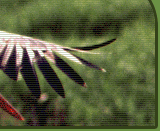Fragmentation of meadow area Description: Drainage ditches have overgrown with bushes thus creating dense shrub/tree belts intersecting the meadows into narrow strips. Although these belts themselves may not occupy large areas and may not significantly reduce the total area of the meadow, they cause fragmentation due to reducing the effective meadow area or core area. See also Annex 1, images 7 and 8. Besides the tree/shrub belts serve as perches for avian predators (such as Corvids) and as sources of shrub seed distribution. Bird species requiring open meadow areas avoid forest edges and tree-lines and this results in significantly lower densities and smaller total population size in the area. Location: All territories chosen as project sites (except Pededzes lejtece and Lielupe floodplains) are affected by this threat. Impact on habitat and species: Although shrub belts along the ditches do not substantially decrease total open area of meadows, they divide them into small patches. Such fragmented meadows hold significantly lower densities of Crex crex* than similar non-fragmented meadows. All of the known leks of Gallinago media in Latvia are located either in meadow areas not affected by fragmentation or in the largest available meadow patch if no such areas are available in floodplain complex. No leks have been found in the patches smaller than 15 ha. Proportion of shaded areas increases in fragmented meadows. Thus unfavourable conditions are created for light demanding plant species causing changes in vegetation structure and decreasing species richness. Habitat types 6210* Semi-natural dry grasslands and scrubland facies on calcareous substrates (Festuco-Brometalia), 6270* Fennoscandian lowland species-rich dry to mesic grasslands and 6410 Molinia meadows on calcareous, peaty or clayey-silt-laden soils (Molinion caeruleae) are most affected by this threat. | 







